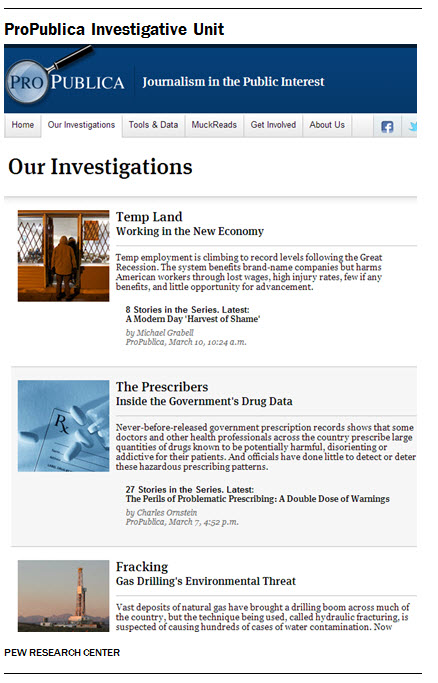Is Digital News Filling Key Reporting Gaps?
In response to a Pew Research survey question from 2012, one official at a digital nonprofit described his editorial mission as “filling the holes that chain media outlets swerve around.” That description gets to the heart of a major question. As cuts in legacy organizations have forced editors to make harder choices about coverage priorities, to what extent are digital news organizations moving to fill those holes in the news ecosystem?
An analysis of the digital native landscape indicates that a number of these organizations are focused on three content areas adversely affected by the economic turmoil in the news industry—local news, international coverage and investigative journalism.
Local news is the focus of a majority of the smaller digital news organizations, many of which were created to cover community and neighborhood events. The uptick in international coverage is coming from the bigger organizations with considerably more financial and human resources, that are rapidly building up overseas bureaus. And the investigative journalism is being produced at both the smaller, more localized organizations—such as the Wisconsin Center for Investigative Journalism—and the larger national outlets, like the Center for Public Integrity in Washington, D.C.
While this report does not include a content analysis of the quality and depth of that local reporting, it is clear that many organizations see these as important editorial niches.
Local News
Alarm bells about the decline in local reporting have been ringing for some time. The John S. and James L. Knight Foundation, in a report “Informing Communities: Sustaining Democracy in the Digital Age, warned “the local journalistic institutions that have traditionally served democracy by promoting values of openness, accountability, and public engagement are themselves in crisis from financial, technological, and behavioral changes taking place in our society.” Three years ago, the Federal Communications Commission concluded that “in many communities, we now face a shortage of local, professional, accountability reporting.” In a 2010 study of the news ecosystem in Baltimore, Pew Research found that the overall number of articles published by The Baltimore Sun in 2009 had dropped 32% from the output of a decade earlier, in 1999.
[was]
While the local television news industry has avoided the kind of severe belt-tightening forced upon newspapers, there is some evidence of a narrowing local TV news agenda now focused on three favorite topics. A Pew Research analysis of local TV news content in 2005, compared with a snapshot sample in late 2012 and early 2013, found the airtime devoted to weather, traffic and sports had risen from 32% of the local newscast studied to 40% —a 25% increase. Indeed, Pew Research’s examination of 48 evening and morning newscasts in late 2012 and early 2013 found that 20 of them led with a weather report or story.
There are also data to suggest that deeper reporting may be less prominent on local television. According to a Pew Research study from 1998 through 2002, some 31% of all the stories on local television news excluding traffic, sports and weather were more than a minute long while 42% were under 30 seconds in length. In 2012, the percentage of stories over a minute long shrank to 20% while the percentage of those that lasted less than half a minute grew to 50%. At the same time, the increasing consolidation of station ownership and the economic advantages of shared resources mean that nearly one-quarter of the almost 1,000 local television stations in the U.S. do not produce local news themselves, but rely on another station.
The primary focus of a majority of smaller digital native news outlets in this report is local, or even hyperlocal coverage—often the most realistic and effective use of their limited resources. More than half of them that we analyzed—231 outlets in all—indicated a focus on local news, either through a narrower or more general topic menu. (That excludes organizations that primarily identified themselves as investigative.) In larger cities, some focused entirely on an individual neighborhood, such as the Leimert Park Beat in Los Angeles and the Park Slope Stoop in Brooklyn In addition, 28 digital news organizations said they concentrated on either state or state government issues.

[such as]
One example of a digital nonprofit helping fill local reporting gaps is the relationship between Charlottesville Tomorrow in Virginia—with a full-time staff of three and an annual budget of around $400,000—and the local paper, The Daily Progress. In the past few years, more than 1,100 Charlottesville Tomorrow stories have been published in The Progress, to the point where the digital outlet says “it produces more than 50 percent of the newspaper’s content related to growth, development, and local politics.”
International News
Another area that has seen significant cutbacks in legacy coverage is international reporting, a trend some analysts trace back to the dissolution of the Soviet Union and the end of the Cold War more than two decades ago. Staff cutbacks at daily newspapers and broadcast television outlets have helped exacerbate that trend.
Andrew Tyndall, who tracks the evening newscasts at ABC, NBC and CBS, counted 1,671 minutes of total coverage with overseas datelines in 2013. That is less than half of what it was in the late 1980’s and is part of a long downward trajectory of overseas coverage on national broadcast news that Tyndall charted.
In 2010, the American Journalism Review conducted a survey that found 234 international correspondents working at U.S. newspapers, down from 307 seven years earlier. That story also reported that 20 papers and newspaper companies had completely eliminated their foreign bureaus since 1998. In 2008, a Pew Research survey of executives at more than 250 newspapers found that nearly two-thirds—64% of them—said international news was getting less space in the paper than it had three years earlier.
From 2007 through 2011, Pew Research examined and coded about 50,000 mainstream media news stories a year. In four of those five years, the percentage of the newshole devoted to overseas events not directly connected to the U.S. ranged only between 10% and 11%. Only in 2011, a year marked by such international mega-stories as the Arab Spring and the Japanese tsunami, did the coverage spike – to 17%.
[including]
Relatively few digital organizations are focused exclusively on international coverage the way Global Post is, but a number of the more prominent digital organizations have recently been expanding and investing overseas at a brisk pace
Business Insider launched a site in Australia in 2013 and plans to open a newsroom in London this year. The two-year-old Quartz operation now has two reporters in London, one in Bangkok and two in Hong Kong. Its editorial staff speaks a combined 19 languages.
The Huffington Post, with 11 international editions, is launching soon in India and may expand to four other countries this year, according to Jimmy Soni. In early March, Vice Media—which was already getting attention for its reporting on the Ukrainian crisis—announced a new global news channel “for a youth audience” backed by the reporting resources of 35 overseas bureaus.

BuzzFeed made a major commitment to international news by bringing on a foreign editor in 2013. And in a memo to staffers, CEO Jonah Peretti said that following the company’s expansion into London, Sydney, São Paulo and Paris, there would soon be new BuzzFeed offices in “Berlin, Tokyo, Mumbai, Mexico City and many more.”
Investigative Journalism
Investigative journalism tends to be expensive because of the time—and staff power—it often takes to unearth, report and vet an investigative exposé before publishing (not to mention the potential cost of lawyers). And it too has felt the effect of legacy newsroom cuts, although there is data to indicate the loss of investigative jobs in mainstream media has been occurring for a while.
In 2005, a survey of the largest U.S. dailies conducted by Arizona State University journalism students found that 37% percent of those newspapers had no full-time investigative or projects reporters on their staffs. The report said that most had two or fewer, and only 10 newspapers had four or more investigative or projects reporters. Nearly two-thirds, 62% percent of the newspapers, did not have an editor tasked with working on investigations and 16% of the dailies reported disbanding a projects or investigative team.
Several years ago, the American Journalism Review reported that membership in the Investigative Reporters and Editors organization had fallen from almost 5,400 in 2003, to about 4,000 in 2010. In explaining its mission on its website, the seven-year-old investigative nonprofit ProPublica states flatly: “Investigative journalism is at risk. Many news organizations have increasingly come to see it as a luxury.”
In this environment, a number of outlets in the digital news landscape are trying to take on the task of investigative journalism. “I like to say this is the fastest growing sector in journalism,” says Kevin Davis, CEO and executive director of the Investigative News Network. Formed in 2009, the organization’s membership has grown to 92—the large majority of which (73) are digital native outlets.
There are a number of modest-sized organizations that have moved into the investigative journalism realm. In our sample of smaller digital news outlets, nearly four dozen (45) identified themselves as investigative news outlets—with many focused on the local or state level. They include such organizations as the Carolina Public Press and New Mexico in Depth.
The New England Center for Investigative Reporting, housed at Boston University, recently hired two Boston Globe reporters for its staff. The center sells its stories to legacy outlets, such as an exposé of the deaths of young children under state protection that ran in The Globe and a look at the unregulated world of smartphone apps offering medical advice that was picked up by The Washington Post.
But much of the investigative muscle in the digital news world comes from some of the larger nonprofit organizations—such as ProPublica, the Center for Investigative Reporting and the Center for Public Integrity, which combined employ almost 130 editorial staffers.

In another sign of the role being played by these investigative outlets, some have been aggressively partnering to produce in-depth exposes with legacy news organizations. That is part of the operating model for ProPublica—a two-time Pulitzer Prize winner—which in 2012 published about 80 stories in conjunction with more than 25 media partners and has worked with such legacy outlets as The New York Times, The Los Angeles Times and PBS’s Frontline. In 2013, the Center for Investigative Reporting teamed up with The Tampa Bay Times to publish an investigation of America’s 50 worst charities.
More recently, The Center for Public Integrity won the Goldsmith Prize for Investigative Reporting—awarded by Harvard University’s Shorenstein Center—for collaboration with ABC News that exposed efforts by doctors and lawyers to deny black lung benefits to sick coal miners. Another of the Center for Public Integrity’s Goldsmith finalists this year—entitled “Secrecy for Sale: Inside the Global Offshore Money Maze”—has run in hundreds of publications around the world, including LeMonde and The New York Times.
New Skills and New Storytelling
One way to gauge how the growth in digital native news is impacting consumers is to look at the coverage areas. Another way—one that often goes hand-in-hand with editorial focus—is how that information is reported and packaged. One thing clearly emerges in conversations with editors at these digital natives moving into more substantial content creation. They talk about hiring younger journalists who are more adept at creating that content for a younger audience.
The eclectic BuzzFeed—where stories about the crisis in Crimea sit side-by-side with videos of contented pet dogs—will never be mistaken for The New York Times. On some level, Vice Media is in the same business as television news, but its six-minute video tour of the opulent mansion of ousted Ukrainian President Viktor Yanukovych—complete with hip hop beats and a wisecracking correspondent—will not remind anyone of a NBC Nightly News segment. And Quartz’s big preview story on the February jobs report—delivered via six charts and minimal text—reflects a different method of economic storytelling.
Quartz editor-in-chief Kevin Delaney, himself a veteran of The Wall Street Journal, says that journalists at new digital organizations need new skill sets. Traditional journalists can “struggle with pace and format,” online, he explained, noting that the classic 800-word newspaper article does not necessarily work in the digital space.
[in the digital world]
Pew Research also tried to analyze the shifts in storytelling by looking at the hiring patterns at digital outlets and trying to determine what percentage of their editorial employees came from legacy news outlets. Not every outlet was able to provide that information, but a few basic patterns emerged.
Former legacy outlet journalists are well represented in the world of small to medium-sized startups, many of them nonprofits. Dylan Smith says most of the staffers at the Local Independent Online News Publishers are “in one way or another, a refugee from chain media, somebody who got laid off and wanted to keep being a journalist or keep covering a place they know or love.” Kevin Davis estimates that of the nearly 600 full-time staffers at the 92 outlets in the Investigative News Network, about 80% came from legacy organizations.
Investigative journalism, he says, “is the pinnacle of the newspaper hierarchy.”
Legacy journalists work in significant numbers at some digital investigative outlets. ProPublica has 25 legacy journalists on its staff of 41. Bill Buzenberg, executive director of the Center of Public Integrity, rattles off 10 legacy news organizations that have contributed talent to his 38-person news staff.
“There are clearly many refugees from legacy news organizations, newspapers and magazines that are getting smaller,” Buzenberg said. “But I think the digital world is also generating up lots of interesting young people who are simply multi-platform journalists and see their work that way.”
A numbers of editors at the digital native organizations say that increasingly, they are looking at younger journalists with a more intuitive sense of the online world.
[about jobs]
“We’re hiring young producers who are capturing and covering news stories in an immersive documentary style that resonates with our audience,” said a Vice Media representative when asked about the skill sets the organization was looking for.
BuzzFeed editorial director Jack Shepherd said that “a lot of our new editors come through our fellows program, which is an incredibly competitive three-month fellowship that trains talented young people to make things that people want to share using BuzzFeed’s platform.”
At Business Insider, Henry Blodget estimates that only about 10% to 15% of the staff came from legacy newsrooms. “Digital is as different from print and TV as they are from each other,” says Blodget. “In addition to being a good journalist, you have to be a good digital storyteller. And that’s very different than being a good print or broadcast storyteller.” Josh Marshall at TPM said about half his 15-person editorial staff are legacy refugees, but adds that he tends to “hire young staff” that haven’t had long careers elsewhere. BuzzFeed’s Ben Smith estimates that 20% to 30% of his editorial staffers are working at their first job.
When asked where he looks to hire staff, The Huffington Post’s Jimmy Soni said, “The most important thing you can do as a modern journalist is be adaptable. We’re bringing people in journalism who never would have thought of themselves as journalists.”




